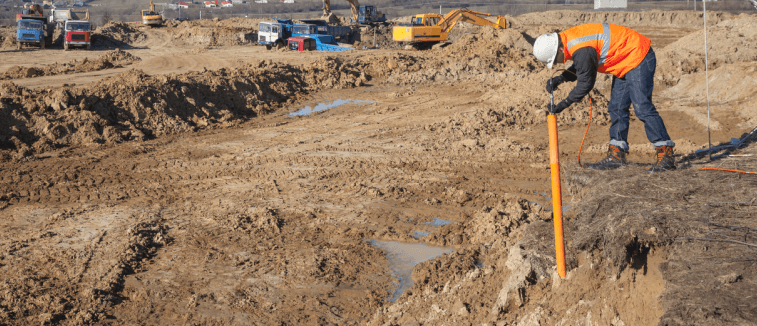The Best Strategy To Use For Geotheta
The Best Strategy To Use For Geotheta
Blog Article
The Of Geotheta
Table of ContentsThe Buzz on GeothetaNot known Facts About GeothetaFacts About Geotheta RevealedExamine This Report about Geotheta
They collaborate with civil designers, structural engineers, designers, and other specialists to integrate geotechnical factors to consider right into the general project design and construction process. This requires efficient team effort, sychronisation, and communication to guarantee that the geotechnical aspects line up with the task goals and fulfill governing needs.Mining & Products Engineering: Principles of drilling, infiltration rates, and variables impacting the selection of drilling approach. Blowing up techniques in surface area and below ground workings. Mechanical and constant methods to fragmentation, consisting of longwall shearing and fullface boring.
Integrated analysis of fragmentation and comminution procedures. Provided by: Mining & Materials Design.
The Main Principles Of Geotheta
Bachelor's degree programs in civil, geotechnical, geological, and ecological design normally last four years and consist of basic education and learning programs in English, social scientific research, and the liberal arts, as well as training courses in innovative mathematics, structural geology, and fluid mineralogy. (https://telegra.ph/Why-Geotheta-is-Your-Go-To-for-Geotechnical-Engineers-in-South-Africa-08-02)
Geotechnical engineering entails the analysis of the soil and rock conditions at a certain website, and their implications for the development of that website. As most structures count on the ground for support, it lacks shock that a comprehensive understanding of the ground conditions, and the suitability of structure systems, are important to the long-term stability and performance of the structure or structure.
Specialising in the investigation of geological formations and ground behaviour, geotechnical engineers perform clinical investigations and testing to comprehend the effect these geological formations may carry the layout and building and construction of structure, civil and framework projects. This competence is essential for the style and construction of structures, roads, passages, dams, bridges, and water and sewer system.
The geotechnical team at Douglas Allies routinely speak with architects, layout designers, designers, and home builders to make suggestions on design and development proposals to make certain that the constructed structures are accordingly designed for the ground problems. For instance, the style of footing systems requires to take into consideration the weight of the structure, the capacity of the ground to support that weight with each other with motion resistances and efficient construction.
Getting My Geotheta To Work
This task is greatly streamlined by the usage of our Douglas Map geospatial system that makes this details readily accessible in a very easy to utilize web browser interface. A geotechnical designer will certainly guide the boring of boreholes and test pits to gather dirt and other examples, and also assess surface functions and ground direct exposures to develop a geotechnical model of the subsurface conditions.
Depending on the project type and ground problems came across, lab screening might to name a few things assess stamina, compressibility, sensitivity and/or permeability of soil and rock examples. After this data is collected and collected, the outcomes are made use of for a geotechnical version of the site, which is usually presented as areas across the website.

A geotechnical examination naturally can only examine the ground problems at the locations drilled or dug deep into. All-natural variants in soil and rock conditions can happen across a site and in between test locations. It is therefore great practice that the geotechnical engineer be maintained throughout building of the job to provide on-site verification that the ground problems run into follow the expectations and recommendations given in the geotechnical investigation report.
The Best Strategy To Use For Geotheta
Geotechnical engineers use their in-depth expertise of soil and rock to assess danger and solve issues on diverse facilities projectsGeotechnical engineering is a specialist branch of civil design which checks out the behaviour of planet products and the application of dirt and rock mechanics. Geo Tech Engineer. As a geotechnical engineer, you will certainly analyze the physical, mechanical and chemical homes of dirt and rock in order to design foundations, maintaining structures and earthworks
Geotechnical design is very closely linked to and overlaps with, both engineering geology and ground engineering - https://geotheta.godaddysites.com/f/why-geotechnical-engineers-are-your-projects-best-friends. It's feasible to be experts in geotechnics or benefit a geotechnical business but be understood as a design geologist or a ground designer. As a geotechnical designer, you'll need to: develop and preserve connections with clients and other specialists entailed in the website, throughout each projectmaintain security requirements on site bear in mind expense ramifications when you make recommendationsstudy geological maps and airborne photos from a series of sources and from different time periodsexamine construction prepares to see exactly how possible they are based upon your understanding of the siteinvestigate dangers or geological dangers for the sitesearch for environmentally delicate attributes, such as landfill begin to develop valid and expository ground modelsplan field investigationsdrill and analyse samples of bedrock, dirt, groundwater and additional materials monitor other experts on sitesolve technological problems as they emerge, such as unforeseen structures at drill sitesmonitor conditions throughout and after building and construction to make certain frameworks are secure in the short and long termadding information accumulated on site to your first researchcreating geotechnical estimations, drawings, and 2 or three-dimensional computer system designs translating the datamaking suggestions regarding the recommended usage of the site

Report this page